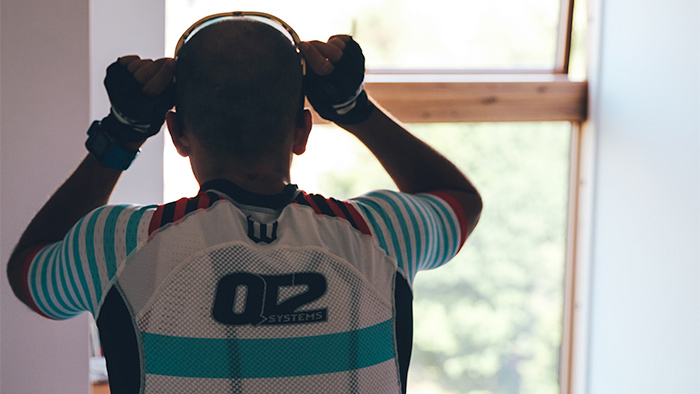What unites most athletes is a desire to perform at our very best at “A” races. However, being able to peak consistently at the right time, in the right place is complex and rarely happens by accident. Rather, it takes discipline, an awesome work-ethic, planning and a very good understanding of the demands of goal races.
In this article, I’ll explore how to prepare for and optimize performance for your “A”race. There are numerous factors that are specific to you that will determine whether you are successful or not.
I can’t cover all of them, but if you take away a few top tips and implement them within your training program then you’ll be on the right path to achieving your goals.
Optimizing Training for your IRONMAN 70.3 Taper
In the run-up to your “A” race, it is more important not to get your training wrong rather than getting it exactly right. Whilst this may seem obvious, the run into a race is often a period of high stress in which we can behave irrationally, trying to cram in extra sessions or worry about everything that could go wrong.
Therefore, planning the final few weeks in which we taper our training can be decisive in optimizing performance. Taper is a systematic reduction in training load in the weeks and days before an important race.
Its aim is to promote recovery from previous training whilst allowing us to gain maximum benefit from training adaptation processes. It is the “cherry on the top on the cake” of a training program, but it will only work if we’ve got our previous training right in the first place.
Joe Friel wrote an excellent article on how to use TrainingPeaks metrics, specifically Training Stress Balance (TSB), which can be used to optimize our taper numbers for race day.
He recognizes the “art” involved in getting training right and as such used the words “probably” and “perhaps” regularly.
Friel recognizes that there are no hard-and-fast rules to determine what an optimal taper looks like or exact numbers that every person will need to hit.
This is because we all respond to training differently, with factors such as travel, race preparation, environmental factors, work-life balance and human irrationality influencing our ability to balance these numbers.
I’ve explored scientific research on how to optimize a taper using different strategies. However, when trying to apply the research to my coaching, I really struggled. That’s because most of the research was performed in a laboratory environment and primarily focused on physical aspects of performance.
Therefore, I was proud to be a co-author of a research paper1 which was one of the first to explore how top-level coaches put the theory of taper into practice for Olympic-level athletes. Whilst they used metrics and taper theory to guide their decision-making, their approach was very holistic and took into account the psychological state of athletes, as well as their physical readiness to perform.
Much of the coaches’ time was spent managing confidence levels, coping with nervousness and irrational behaviours. The coaches also told us that athletes have their “go-to” sessions, which help them build and maintain confidence.
They are careful to ensure that sessions are “hard enough” without accumulating additional fatigue. Technical fine-tuning and athlete enjoyment were also priorities.
The key take-home message is that we need to go beyond the metrics, recognizing that to perform at our best requires a greater focus on both the psychological and practical aspects of performance.
Of course, we should not neglect the numbers and TrainingPeaks is still the best tool available to get the TSB within Joe’s ballpark range.
Managing “Self” in the Run-Up to an “A” Race
So, what do we need to do to go beyond the numbers and achieve our peak performance? We can certainly learn from digging deeper into some basic sport psychology tools.
One thing I like to do with athletes is to explore their beliefs and perceptions relating to their “A” race. By listing fears into controllable and uncontrollable factors and then put strategies in place to deal with them is a great way to do it.

Pre-race anxiety is heightened by the “fight or flight” response, resulting in many athletes coming up with multiple excuses as to why they may not perform. It also makes some of us very difficult to live with in the run up to a race.
We often experience a heightened sense of threat within our environment and greater body awareness in which minor twinges seem like career-threatening injuries. By recognizing and accepting such feelings for what they are, it becomes easier to cope with these pre-race anxieties.
Because of the significant time-commitment we put into our sport, many of us worry about letting significant others down if we perform below par. Simply by accepting that the feelings of those who love or care about us are not dependent on your performance can help alleviate fear of failure.
Another fear with many athletes is that we lack confidence in our race preparation such as not training hard or long enough. The fact is that even if there is some basis of truth in your beliefs, holding on to these negative feelings won’t be helpful on race day.
Rather, if you’ve reached the final two-weeks underprepared, then it’s impossible to make up for lost time. A good strategy to overcome this lack of confidence is to think about a race or session that you have felt below-par and have still performed relatively well. By doing so and then focusing on the processes we can control, it is easier to develop the belief that a good— if not great—performance is still attainable.
Go-to Sessions
The taper period can be a particularly challenging time mentally for athletes. This is not only due to pre-race anxieties but also because some physiological changes that occur during the taper may influence how we feel and behave.
Training rewards us by releasing feel-good hormones such as opioids, catecholamines and dopamine. With reduced training load, we may not get our regular “hit,” and such deprivation can lead to feelings of low mood, increased tension and fatigue.
Such feelings are normal, and they are rarely markers of a loss in fitness or impending doom. Most importantly, they are certainly not an excuse to do an extra few sessions. To alleviate negative feelings, most top athletes have “go-to” sessions which can help overcome negative feelings, grow confidence and fine-tune their engine.
I am not overly concerned about the session content or achieving a specific TSB, as long as training does not result in excess fatigue and the athlete enjoys doing it. This is because the hard work should already have been done in the preceding months.
The bike session below has been designed to help an athlete prepare for an IRONMAN 70.3 race. It is a hard one that includes race-specific as well as maximal (aerobic) efforts. Pushing to the max releases these feel-good hormones and may also result in up-regulation of aerobic enzymes, which help further fine-tune the aerobic engine.
Workout Details
1. Warm up
- 10 min @ 50% FTP
2. Ramp it up in 3 steps
- Easy: 4 min @ 60% FTP
- Moderate: 4 min @ 75% FTP
- Moderately Hard: 4 min @ 90% FTP
3. Recovery, 5 min @ 55% FTP
4. Repeat 3 times
- 70.3 Pace: 10 min @ 87% FTP
- Max the aerobic engine: 3 min @ 130% FTP
- Recovery: 5 min @ 55% FTP
5. Cool Down
- 9 min @ 40% FTP
Duration: 1:30:00
IF: 0.86
TSS: 110.7
References
Ritchie, D. et al. (2017, August 7). Where science meets practice: Olympic coaches’ crafting of the tapering process. Retrieved from https://www.tandfonline.com/doi/full/10.1080/02640414.2017.1362717



